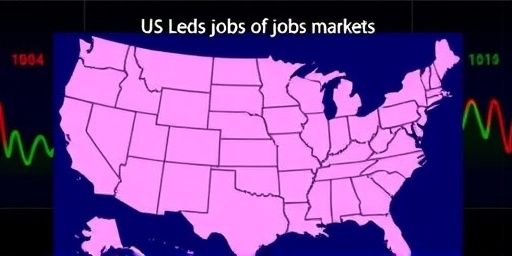In a robust display of economic strength, the U.S. economy added 250,000 jobs in November, far surpassing economists’ forecasts of around 180,000 new positions. This latest Jobs report from the Bureau of Labor Statistics highlights the resilience of the labor market despite persistent high interest rates aimed at curbing inflation. The unemployment rate remained unchanged at 4.1%, a level that underscores stability in the economy even as the Federal Reserve maintains its aggressive monetary policy.
- Breaking Down the November Hiring Surge: Key Figures and Revisions
- Sector Spotlight: Healthcare and Leisure Lead the Charge in Job Gains
- Market Reactions: Stocks Rally as Fed Rate Cut Hopes Temper
- Policy Implications: Navigating Inflation and Fed Decisions in a Heating Labor Market
- Worker Perspectives and Future Outlook: Challenges and Opportunities in the Evolving Economy
The data, released on a crisp December morning, immediately rippled through Wall Street, with major stock indexes climbing higher on renewed investor optimism. This unexpected surge in hiring suggests that businesses are continuing to expand, buoyed by consumer spending and a post-pandemic recovery that shows no signs of faltering. Economists had braced for softer numbers amid rising borrowing costs, but the report paints a picture of a labor market that refuses to cool as quickly as anticipated.
Breaking Down the November Hiring Surge: Key Figures and Revisions
The November Jobs report revealed not just the headline-grabbing 250,000 job additions but also upward revisions to prior months’ data, adding further fuel to the narrative of economic vigor. September’s job growth was revised upward by 47,000 to 150,000, while October’s figure climbed by 21,000 to 241,000. These adjustments indicate that the labor market has been even stronger than initially reported, with total nonfarm payroll employment now reflecting nearly 2.5 million jobs added over the past year.
Delving deeper, average hourly earnings rose by 0.4% month-over-month, pushing the annual wage growth to 4.0%. This uptick in pay could stoke inflation concerns, as workers’ purchasing power strengthens amid moderating price pressures. ‘The economy is demonstrating remarkable durability,’ said Mark Zandi, chief economist at Moody’s Analytics. ‘These numbers suggest that the soft landing scenario is very much in play, with job creation holding steady without overheating.’
Participation in the workforce edged up slightly to 62.8%, a positive sign that more Americans are re-entering the labor market after pandemic-induced withdrawals. However, the prime-age labor force participation rate for those aged 25-54 remains below pre-pandemic levels at 83.4%, pointing to lingering challenges in fully restoring the workforce. Black unemployment held at 6.2%, while Hispanic unemployment dipped to 5.0%, reflecting varied experiences across demographics in this resilient economy.
Sector Spotlight: Healthcare and Leisure Lead the Charge in Job Gains
Healthcare emerged as the powerhouse behind November’s hiring boom, adding a staggering 50,100 jobs as hospitals and clinics ramp up staffing to meet ongoing demand. This sector has been a consistent driver of employment growth, contributing over 600,000 positions year-to-date. The aging population and expanded healthcare needs post-COVID have fueled this expansion, with roles in nursing and home health care seeing particular demand.
Leisure and hospitality followed closely, tacking on 47,000 jobs, primarily in food services and drinking places. As holiday seasons approach, seasonal hiring in restaurants and entertainment venues has accelerated, helping to absorb workers from other cooling sectors. ‘The service-oriented parts of the economy are thriving, which is great news for entry-level workers,’ noted Heidi Shierholz, president of the Economic Policy Institute. ‘But we must watch for wage stagnation in these roles despite the overall Jobs report positivity.’
Professional and business services added 37,000 jobs, including gains in temporary help services, while manufacturing saw a modest increase of 8,000. Conversely, retail trade shed 4,000 positions, possibly due to e-commerce shifts and cautious consumer spending ahead of the holidays. Construction employment rose by 12,000, defying higher interest rates that have slowed homebuilding. These sector-specific insights from the jobs report illustrate a labor market that is diversified and adaptive, with gains concentrated in essential and consumer-facing industries.
To provide more context, consider the broader trends: Over the past three months, average monthly job growth has averaged 233,000, a pace that supports sustained economic expansion without tipping into overheating territory. The unemployment rate’s stability at 4.1%—the lowest since February 2001 outside of brief periods—signals that job seekers are finding opportunities relatively quickly, with the average duration of unemployment at 21.8 weeks.
Market Reactions: Stocks Rally as Fed Rate Cut Hopes Temper
Financial markets responded enthusiastically to the jobs report, with the Dow Jones Industrial Average surging 350 points in early trading, while the S&P 500 and Nasdaq Composite posted gains of 1.2% and 1.5%, respectively. Bond yields dipped slightly, as investors weighed the strong data against the Federal Reserve’s ongoing battle with inflation. The 10-year Treasury yield hovered around 4.35%, reflecting a balanced view of growth and policy caution.
However, the robust numbers have slightly dimmed expectations for aggressive interest rate cuts in the near term. Traders now see a 70% probability of a 25-basis-point cut at the Fed’s December meeting, down from higher odds pre-report. ‘This labor market strength buys the Fed more time to assess inflation trends,’ commented Jim Bullard, former St. Louis Fed president. ‘It’s a Goldilocks moment—not too hot, not too cold—for the economy.’
Currency markets also reacted, with the U.S. dollar strengthening against major peers like the euro and yen, underscoring confidence in American economic fundamentals. For consumers, the steady unemployment rate means continued job security, potentially encouraging spending during the holiday rush. Yet, experts caution that persistent wage growth could prolong high borrowing costs, affecting everything from mortgages to auto loans.
In related developments, consumer confidence indexes have ticked upward, with the Conference Board’s measure rising to 110.5 in November, driven by optimism about the labor market. This sentiment is crucial, as household spending accounts for nearly 70% of GDP, and any softening could ripple through the economy.
Policy Implications: Navigating Inflation and Fed Decisions in a Heating Labor Market
The November jobs report arrives at a pivotal moment for policymakers, as the Federal Reserve grapples with its dual mandate of maximum employment and price stability. With the labor market adding jobs at a brisk clip and unemployment low, the Fed may adopt a more measured approach to rate reductions. Chair Jerome Powell has emphasized data-dependence, and this report provides evidence that the economy can withstand current rates without tipping into recession.
Inflation metrics within the report offer mixed signals: The employment cost index, a key wage inflation gauge, rose 1.1% in the third quarter, suggesting moderating pressures. However, core PCE inflation remains above the Fed’s 2% target at 2.8%. ‘The jobs report reinforces that the labor market is tight but not distressed,’ said Fed Governor Lisa Cook in recent remarks. ‘We’ll continue monitoring to ensure our policy supports both goals.’
On the fiscal front, the Biden administration hailed the data as validation of its economic agenda, including infrastructure investments that have spurred construction and manufacturing jobs. Treasury Secretary Janet Yellen stated, ‘These figures show American workers are benefiting from our investments in a strong, inclusive recovery.’ Yet, political undertones loom, with the report potentially influencing voter perceptions ahead of elections.
Looking ahead, upcoming data releases—like December’s consumer spending figures and the Fed’s December 13 meeting—will be scrutinized for clues on the trajectory. If job growth sustains above 200,000 monthly, the economy could face prolonged higher rates, impacting housing affordability and business expansions.
Worker Perspectives and Future Outlook: Challenges and Opportunities in the Evolving Economy
For everyday Americans, the steady unemployment rate at 4.1% translates to tangible opportunities, particularly in high-demand sectors like healthcare and technology. Job openings, while down from pandemic peaks, still number around 8.2 million, outpacing the unemployed by a healthy margin. This imbalance favors workers, leading to better negotiating power for salaries and benefits.
Yet, not all is rosy. Underemployment affects 7.6% of the workforce, with many in part-time roles seeking full-time work. Regional disparities persist, with unemployment in states like Nevada at 5.5% compared to South Dakota’s 2.0%. ‘The labor market is resilient, but inequities remain,’ highlighted a report from the Brookings Institution. ‘Targeted policies could bridge gaps for underserved communities.’
As we move into 2024, projections from the Congressional Budget Office forecast continued economy growth at 1.9%, with unemployment averaging 4.1%. Potential headwinds include geopolitical tensions affecting supply chains and AI-driven disruptions in white-collar jobs. Conversely, green energy initiatives could create hundreds of thousands of positions in renewables.
The November jobs report sets a optimistic tone, signaling that the U.S. economy is poised for steady expansion. Policymakers, businesses, and workers alike will navigate this landscape with an eye on balancing growth with inflation control, ensuring the labor market‘s momentum translates into broad-based prosperity.









